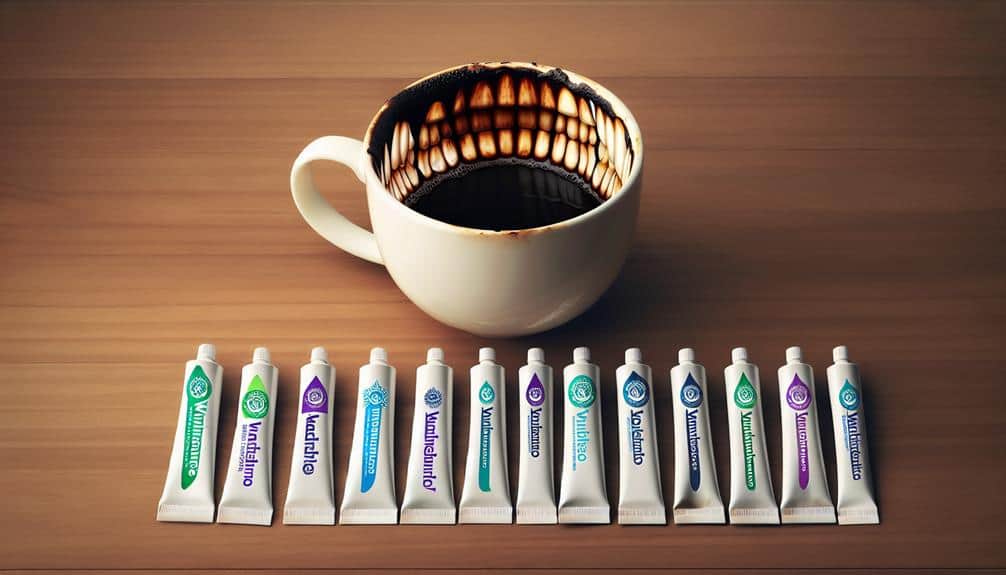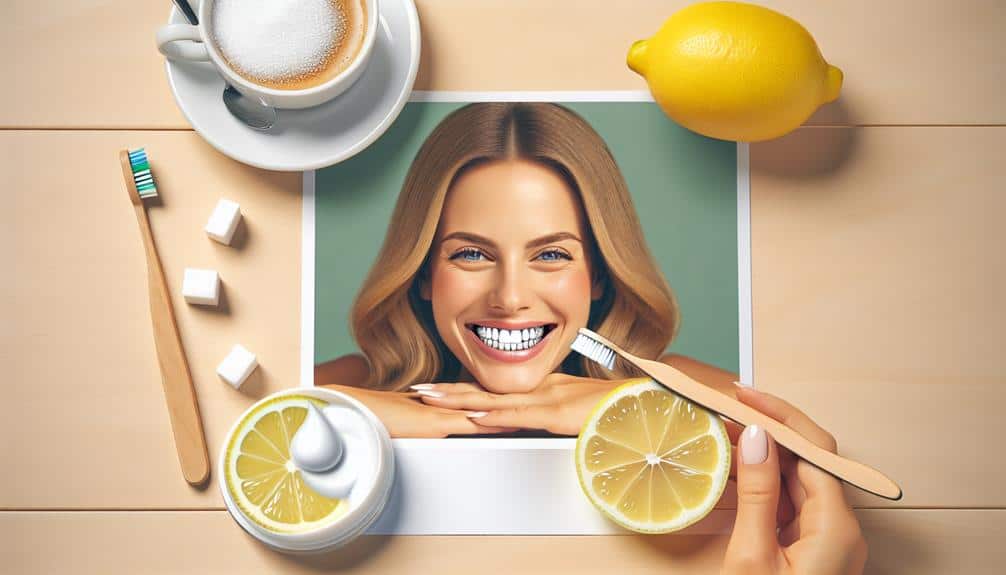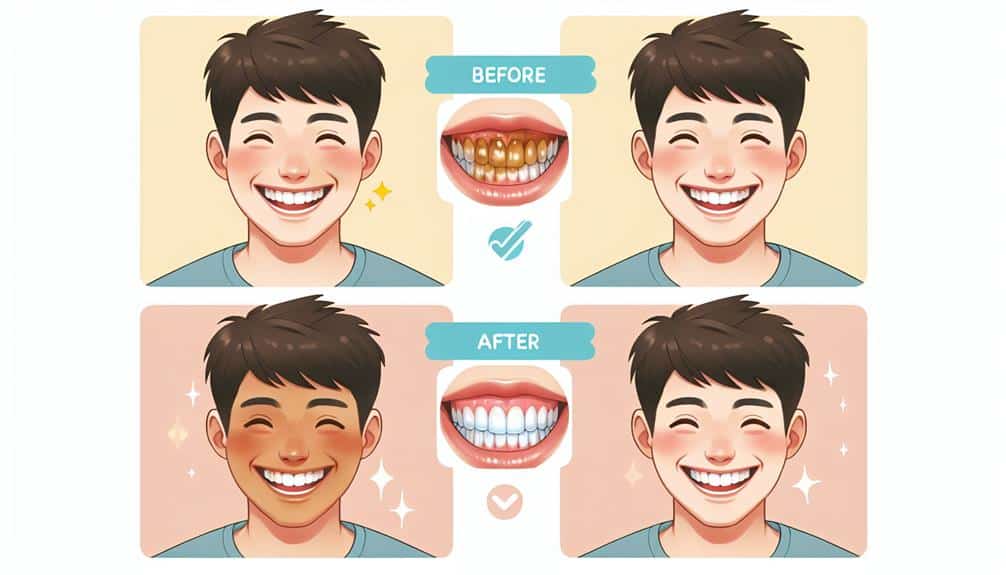For those stubborn coffee stains on your teeth, opt for whitening toothpaste with hydrogen peroxide. It's proven to effectively tackle those discolorations and give you a brighter smile. Stick to a consistent oral care routine to maintain those pearly whites. Be proactive in choosing a toothpaste that suits your oral health needs, including fluoride for enamel strength and desensitizing agents for sensitivity relief. Discover the secrets to a radiant smile by exploring the various ingredients and techniques for stain removal. A dazzling smile is just a brush away with the right toothpaste.
Key Points
- Look for toothpaste with hydrogen peroxide to break down stains effectively.
- Consider baking soda for gentle scrubbing of surface stains.
- Choose a toothpaste with fluoride to strengthen enamel.
- Opt for potassium nitrate for desensitizing properties.
- Natural alternatives like charcoal may offer additional stain-fighting benefits.
Understanding Coffee Stains on Teeth
Understanding the impact of coffee stains on your teeth is essential for selecting the most effective whitening toothpaste. Coffee stains on teeth are caused by chromogens, compounds with strong pigments that adhere to enamel. Additionally, coffee is acidic, which can weaken tooth enamel, making it more susceptible to staining. The porous nature of enamel allows these pigments to seep into the tooth, resulting in those stubborn yellowish-brown stains.
Prevention is key to managing coffee stains on teeth. One important way is to limit the intake of coffee or use a straw to bypass direct contact with teeth. Rinsing your mouth with water after consuming coffee can help reduce the amount of time the pigments have to adhere to the enamel. Regular dental cleanings and maintaining good oral hygiene practices, such as brushing and flossing, are also vital in preventing and managing coffee stains.
Choosing the Right Whitening Toothpaste
To select the most effective whitening toothpaste for coffee stains, consider the specific needs of your teeth and oral health goals. When choosing a whitening toothpaste, there are several factors to keep in mind:
- Brand Comparison: Different brands offer various formulations and technologies in their whitening toothpaste. Research and compare brands to find one that best suits your needs.
- Fluoride Content: Look for toothpaste that contains fluoride, as it helps strengthen enamel and prevent tooth decay. Fluoride is essential for maintaining good oral health.
- Sensitivity Relief and Enamel Protection: If you have sensitive teeth or are concerned about enamel erosion, opt for a whitening toothpaste that offers sensitivity relief and enamel protection. These features can help prevent discomfort while whitening your teeth.
Ingredients to Look for in Toothpaste
Consider incorporating key ingredients like hydrogen peroxide, baking soda, and potassium nitrate when selecting a whitening toothpaste for effective stain removal. Hydrogen peroxide is a common whitening agent that can penetrate the tooth enamel to break down stains effectively. Baking soda, known for its mild abrasive properties, can gently scrub away surface stains without causing damage to the enamel. Potassium nitrate, on the other hand, helps to desensitize the teeth, making it a suitable addition for those with sensitive teeth.
When choosing a whitening toothpaste, it's also essential to look for fluoride benefits. Fluoride helps to strengthen tooth enamel, making it more resistant to acid attacks that can lead to staining. Additionally, natural alternatives like charcoal have gained popularity in recent years for their purported whitening properties, although more research is needed to support these claims. Baking soda benefits include its ability to neutralize acids in the mouth and remove surface stains effectively.
Tips for Effective Stain Removal
Looking to tackle those stubborn coffee stains on your teeth effectively? Here are some quick solutions and DIY remedies to help you achieve a brighter smile:
- Baking Soda: Create a paste using baking soda and water, then gently brush it onto your teeth. Baking soda is known for its mild abrasiveness, which can help scrub away surface stains effectively.
- Hydrogen Peroxide: Mix a small amount of hydrogen peroxide with water and swish it around in your mouth for a minute or two before spitting it out. Hydrogen peroxide is a natural bleaching agent that can help lighten stains on your teeth.
- Oil Pulling: Consider incorporating oil pulling into your oral care routine. Swish a tablespoon of coconut oil in your mouth for about 15-20 minutes, then spit it out. Oil pulling is believed to help remove toxins and bacteria from your mouth, potentially reducing stains over time.
These simple tips can be effective in tackling coffee stains on your teeth, providing you with a brighter and healthier smile.
Maintaining a Bright Smile
Maintaining a bright smile involves consistent oral care practices and regular visits to your dentist for professional cleanings. Good dental hygiene is essential for preserving the whiteness of your teeth. Brushing at least twice a day with a fluoride toothpaste helps remove plaque and prevent stains. Flossing daily is also essential in reaching areas between teeth where your toothbrush may not reach, preventing decay and discoloration. Furthermore, using a mouthwash can help kill bacteria that cause bad breath and contribute to staining.
Enamel protection is another key aspect of maintaining a bright smile. Enamel is the outermost layer of your teeth and plays a crucial role in safeguarding against decay and stains. To protect your enamel, avoid acidic foods and beverages that can erode it. Additionally, consider using toothpaste with ingredients like fluoride and calcium that strengthen enamel. Regular dental check-ups are important for monitoring your enamel's health and addressing any issues promptly. By prioritizing dental hygiene and enamel protection, you can maintain a radiant smile for years to come.
Frequently Asked Questions
Can Coffee Stains on Teeth Be Prevented From Forming in the First Place?
To prevent coffee stains on teeth, focus on preventive measures and dental care strategies. Regular brushing, flossing, and dental check-ups can help maintain oral hygiene. Limiting coffee intake or using a straw can also reduce staining.
Are There Any Natural Remedies That Can Help Remove Coffee Stains From Teeth?
To get rid of coffee stains on teeth, consider herbal remedies like oil pulling. Mix baking soda with apple cider vinegar for a natural solution. Consistent use can help brighten your smile. Prioritize oral hygiene.
How Often Should Whitening Toothpaste Be Used to Effectively Combat Coffee Stains?
To effectively combat coffee stains, use whitening toothpaste regularly. The frequency of use plays a vital role in its effectiveness. Consistent usage helps prevent new stains and maintain a brighter smile. Follow recommended guidelines for the best results.
Is It Possible to Over-Whiten Teeth With Whitening Toothpaste, and What Are the Potential Risks?
Brushing excessively with whitening toothpaste may lead to tooth sensitivity and enamel damage. It's important to follow product instructions and not overdo it. Over-whitening can weaken enamel, causing risks like increased sensitivity and potential harm to your teeth.
Are There Any Specific Dietary Habits That Can Help Prevent Coffee Stains From Reoccurring After Using Whitening Toothpaste?
To prevent coffee stains after using whitening toothpaste, consider coffee alternatives and diet suggestions. Tea stains can also be avoided with preventive measures. Incorporate these changes into your routine for a brighter smile.



